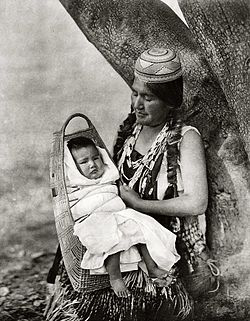Hupa
+Add origin to My Preferences Hupa, also spelled Hoopa are a Native American people of the Athabaskan-speaking ethnolinguistic group in northwestern California. Their autonym is Natinixwe, also spelled Natinookwa, meaning "People of the Place Where the Trails Return". The majority of the tribe is enrolled in the federally recognized Hoopa Valley Tribe.
Hupa, also spelled Hoopa are a Native American people of the Athabaskan-speaking ethnolinguistic group in northwestern California. Their autonym is Natinixwe, also spelled Natinookwa, meaning "People of the Place Where the Trails Return". The majority of the tribe is enrolled in the federally recognized Hoopa Valley Tribe.
History
The Hupa people migrated from the north into northern California around 1000 CE and settled in Hoopa Valley, California. Their heritage language is Hupa, which is a member of the Athabaskan language family. Their land stretched from the South Fork of the Trinity River to Hoopa Valley, to the Klamath River in California. Their red cedar-planked houses, dugout canoes, basket hats, and many elements of their oral literature identify them with their northern origin; however, some of their customs, such as the use of a sweat house for ceremonies and the manufacture of acorn bread, were adopted from surrounding indigenous peoples of California.
Hupa people had limited contact with non-native peoples until the 1849 Gold Rush brought an influx of miners onto their lands. In 1864, the United States government signed a treaty that recognized the Hupa tribe's sovereignty to their land. The United States called the reservation the Hoopa Valley Indian Reservation, where the Hupa now reside. The reservation is next to the territory of the Yurok at the connection of the Klamath and Trinity Rivers in northeastern Humboldt County. The reservation has a land area of 141.087 square miles.
Arts
Hupa people have traditionally excelled at basketry, elk horn carving, and since the 17th century, petroglyphs.
Ethnobotany
The Hupa use the acorns of lithocarpus densiflorus to make meal, from which they would make mush, bread, biscuits, pancakes, and cakes. They also roast the acorns and eat them. They also use the dyed fronds of woodwardia radicans for basketry. They also use xerophyllum tenax to create a border pattern in baskets.
Text Source: Wikipedia
Photo Source: Wikipedia (Hupa Mother and Infant, ca 1924, photo by Edward Curtis)
View Items from other Tribes Here:
- Acoma Pueblo, Haak’u
- Akimel O'odham, Pima
- Apache, American Indians
- Cochiti Pueblo, KO-TYIT
- Diné of the Navajo Nation
- Hopi Pueblo, Hopituh Shi-nu-mu
- Isleta Pueblo, Tue-I
- Jemez Pueblo, Walatowa
- KEWA, Santo Domingo Pueblo
- Kiowa Nation
- Laguna Pueblo, Ka'waika
- Maricopa, Peeposh Tribe
- Mojave Tribe
- Nambe Pueblo, Nanbé Ówingeh
- Ohkay Owingeh, San Juan Pueblo
- Picuris Pueblo, Pe’ewi
- Pojoaque Pueblo, PO-SUWAE-GEH
- Potawatomi Nation
- San Felipe Pueblo, Katishtya
- San Ildefonso Pueblo, Po-woh-ge-oweenge
- Sandia Pueblo, NA-FIAT
- Santa Ana Pueblo, Tamaya
- Santa Clara Pueblo, Kha'p'oo Owinge
- Taos Pueblo, Tuah-Tah
- Tesuque Pueblo, TET-SUGEH
- Tohono O´odham, Papago
- Zia Pueblo, Tsi-ya
- Zuni Pueblo, SHE-WE-NA

